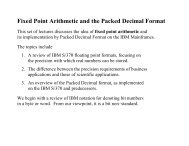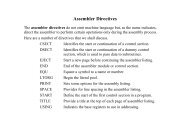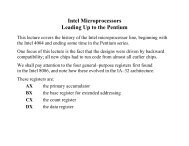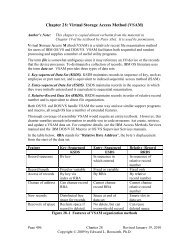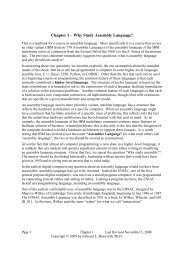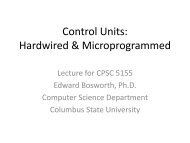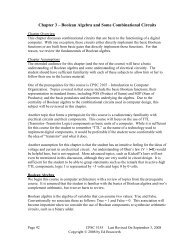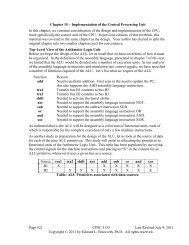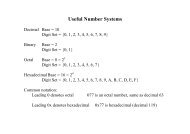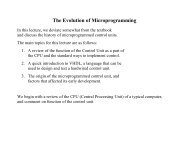PDF Version - Edwardbosworth.com
PDF Version - Edwardbosworth.com
PDF Version - Edwardbosworth.com
Create successful ePaper yourself
Turn your PDF publications into a flip-book with our unique Google optimized e-Paper software.
S/370 Assembler Language Binary Integer Data<br />
The sum is used as a shift count, not as an address. The two conventional uses are to specify<br />
a constant shift count and to use a register to contain the shift count. Consider the following<br />
two examples, each of which uses theSRA instruction with opcodeX‘8A’.<br />
Object Code<br />
Source Code<br />
8A 90 00 0A SRA 9,10 BASE REGISTER = 0, DISPLACEMENT<br />
= 10; THE SHIFT COUNT IS 10.<br />
8A 90 B0 00<br />
SRA 9,0(11) HERE REGISTER 11 (X‘B’) CONTAINS<br />
THE SHIFT COUNT.<br />
Example Object Code Analysis: SLL<br />
Shift Left Logical Operation code =X‘89’<br />
This is also a type RS instruction, though the appearance of a typical use seems to deny<br />
this. Consider the following instruction which shifts R6 left by 12 bits.<br />
SLL R6, 12 Again, I assume we have set R6 EQU 6<br />
The above would be assembled as89 60 00 0C, as decimal 12 isX‘C’.<br />
The deceptive part concerns the value 12, used for the shift count. Where is that stored?<br />
The answer is that it is not stored, but is used as a value for the shift count.<br />
The object code 00 0C literally indicates the <strong>com</strong>putation of a value that is an sum of<br />
decimal 12 from the value in base register 0. But “0” indicates that no base register is<br />
used, hence the value for the shift is decimal 12.<br />
Here are three lines from a working program I wrote on 2/23/2009.<br />
000014 5840 C302 00308 47 L R4,=F’1’<br />
000018 8940 0001 00001 48 SLL R4,1<br />
00001C 8940 0002 00002 49 SLL R4,2<br />
Note that the load instruction makes use of a literal. The assembler will create an entry in the<br />
literal pool and populate it with the value 1. Here, my code calls for register 12 (X‘C’) to<br />
serve as the base register. The literal is stored at offsetX‘302’ from the address stored<br />
in that base register.<br />
While it might seem plausible that the SLL instructions similarly generate literals, this is not<br />
the case. In each, as noted above, the value is stored as a count in the base/displacement<br />
format, which is here pressed into duty to store a value and not an address.<br />
Page 238 Chapter 12 Last Revised July 6, 2009<br />
Copyright © 2009 by Edward L. Bosworth, Ph.D.



